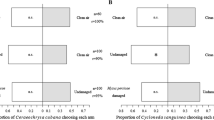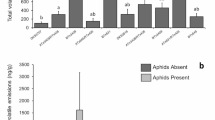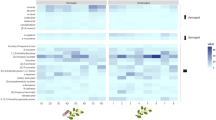Abstract
Natural enemies of insect herbivores use volatile organic compounds (VOCs) released by plants to locate suitable patches for foraging. When a plant is damaged by herbivores, it can modify its VOC profile, enhancing attraction of the herbivore’s natural enemies. In both natural and agricultural ecosystems, plants are usually attacked by more than one species of herbivore, either simultaneously or sequentially. Different herbivores, even those with similar feeding habits, can activate different defensive responses in the same plant and this can alter the attraction of natural enemies. This study aimed to understand how simultaneous and sequential damage to sweet pepper, Capsicum annuum, by two aphid species, Aphis gossypii and Myzus persicae, affects attraction of the aphid predator Cycloneda sanguinea to plant odours. Undamaged plants did not attract C. sanguinea, but plants damaged by either aphid were attractive to this predator. When plants were damaged simultaneously, the predator did not distinguish between the odours of plants damaged by both species from those damaged by a single species. When damage was sequential, a certain combination of damage (A. gossypii followed by M. persicae) made the plants more attractive than plants damaged by A. gossypii only. Odour from plants from all other combinations of sequential damage proved equally attractive to C. sanguinea as plants damaged by a single species. The study allows us to conclude that, unlike for simultaneous damage, a specific sequence of sequential damage enhances attraction of the predator. This could potentially create enemy-dense space on previously damaged plants.



Similar content being viewed by others
References
Agbogba BC, Powell W (2007) Effect of the presence of a non-host herbivore on the response of the aphid parasitoid Diaeretiella rapae to host-infested cabbage plants. J Chem Ecol 33:2229–2235. doi:10.1007/s10886-007-9379-x
Alborn HT, Turlings TCJ, Jones TH, Stenhagen G, Loughrin JH, Tumlinson JH (1997) An elicitor of plant volatiles from beet armyworm oral secretion. Science 276:945–948
Almeida LM, Ribeiro-Costa CS (2009) Coleopteros predadores (Coccinellidae). In: Panizzi AR, Parra JRP (eds) Bioecologia e Nutrição de Insetos: Base para o Manejo Integrado de Pragas. Embrapa Informação Tecnológica, Brasília, pp 931–968
Bernasconi ML, Turlings TCJ, Ambrosetti L, Bassetti P, Dorn S (1998) Herbivore-induced emissions of maize volatiles repel the corn leaf aphid, Rhopalosiphum maidis. Entomol Exp Appl 87:133–142
Bostock RM (2005) Signal crosstalk and induced resistance: straddling the line between cost and benefit. Annu Rev Phytopathol 43:545–580
Bruce TJA, Pickett JA (2011) Perception of plant volatile blends by herbivorous insects—Finding the right mix. Phytochemistry 72:1605–1611. doi:10.1016/j.phytochem.2011.04.011
Bukovinszky T, Poelman EH, Kamp A, Hemerik L, Prekatsakis G, Dicke M (2012) Plants under multiple herbivory: consequences for parasitoid search behaviour and foraging efficiency. Anim Behav 83:501–509. doi:10.1016/j.anbehav.2011.11.027
de Boer JG, Posthumus MA, Dicke M (2004) Identification of volatiles that are used in discrimination between plants infested with prey or non-prey herbivores by a predatory mite. J Chem Ecol 30:2215–2230
de Boer JG, Snoeren TAL, Dicke M (2005) Predatory mites learn to discriminate between plant volatiles induced by prey and non-prey herbivores. Anim Behav 69:869–879
de Boer JG, Hordijk CA, Posthumus MA, Dicke M (2008) Prey and non-prey arthropods sharing a host plant: effects on induced volatile emission and predator attraction. J Chem Ecol 34:281–290
De Moraes CM, Lewis WJ, Paré PW, Alborn HT, Tumlinson JH (1998) Herbivore-infested plants selectively attract parasitoids. Nature 393:570–573
De Moraes CM, Mescher MC, Tumlinson JH (2001) Caterpillar-induced nocturnal plant volatiles repel conspecific females. Nature 410:577–580
de Rijk M, Dicke M, Poelman EH (2013) Foraging behaviour by parasitoids in multiherbivore communities. Anim Behav 85:1517–1528. doi:10.1016/j.anbehav.2013.03.034
Du Y-J, Poppy GM, Powell W (1996) Relative importance of semiochemicals from first and second trophic levels in host foraging behavior of Aphidius ervi. J Chem Ecol 22:1591–1605
Du Y-J, Poppy GM, Powell W, Pickett JA, Wadhams LJ, Woodcock CM (1998) Identification of semiochemicals released during aphid feeding that attract the parasitoid Aphidius ervi. J Chem Ecol 24:1355–1368
Erb M, Foresti N, Turlings TCJ (2010) A tritrophic signal that attracts parasitoids to host-damaged plants withstands disruption by non-host herbivores. BMC Plant Biology 10. doi:10.1186/1471-2229-10-247
Gencer NS, Kumral NA, Sivritepe HO, Seidi M, Susurluk H, Senturk B (2009) Olfactory response of the ladybird beetle Stethorus gilvifrons to two preys and herbivore-induced plant volatiles. Phytoparasitica 37:217–224. doi:10.1007/s12600-009-0032-9
Han BY, Chen ZM (2002) Behavioral and electrophysiological responses of natural enemies to synomones from tea shoots and kairomones from tea aphids, Toxoptera aurantii. J Chem Ecol 28:2203–2219
Hare JD (2011) Ecological role of volatiles produced by plants in response to damage by herbivorous insects. Annu Rev Entomol 56:161–180
Hare JD, Sun JJ (2011) Production of induced volatiles by Datura wrightii in response to damage by insects: effect of herbivore species and time. J Chem Ecol 37:751–764. doi:10.1007/s10886-011-9985-5
Hatano E, Kunert G, Michaud JP, Weisser WW (2008) Chemical cues mediating aphid location by natural enemies. Eur J Entomol 105:797–806
Heil M (2008) Indirect defence via tritrophic interactions. New Phytol 178:41–61. doi:10.1111/j.1469-8137.2007.02330.x
Hoballah ME, Turlings TCJ (2005) The role of fresh versus old leaf damage in the attraction of parasitic wasps to herbivore-induced maize volatiles. J Chem Ecol 31:2003–2018. doi:10.1007/s10886-005-6074-7
Lins Jr. JC, Loon JJAv, Bueno VHP, Lucas-Barbosa D, Dicke M, Lenteren JCv (In Press) Response of the zoophytophagous predators Macrolophus pygmaeus and Nesidiocoris tenuis to volatiles of uninfested plants and to plants infested by prey or conspecifics. BioControl. doi:10.1007/s10526-014-9602-y
Kessler A, Baldwin IT (2001) Defensive function of herbivore-induced plant volatile emissions in nature. Science 291:2141–2144. doi:10.1126/science.291.5511.2141
Kessler A, Halitschke R (2007) Specificity and complexity: the impact of herbivore-induced plant responses on arthropod community structure. Curr Opin Plant Biol 10:409–414. doi:10.1016/j.pbi.2007.06.001
Martínez AS, Hardie J (2009) Hygroreception in olfactometer studies. Physiol Entomol 34:211–216. doi:10.1111/j.1365-3032.2009.00675.x
Mattiacci L, Dicke M, Posthumus MA (1995) ß-Glucosidase: an elicitor of herbivore-induced plant odor that attracts host-searching parasitic wasps. Proc Natl Acad Sci USA 92:2036–2040
Moayeri HRS, Ashouri A, Poll L, Enkegaard A (2007) Olfactory response of a predatory mirid to herbivore induced plant volatiles: multiple herbivory vs. single herbivory. J Appl Entomol 131:326–332. doi:10.1111/j.1439-0418.2007.01177.x
Moraes MCB, Laumann R, Sujii ER, Pires C, Borges M (2005) Induced volatiles in soybean and pigeon pea plants artificially infested with the neotropical brown stink bug, Euschistus heros, and their effect on the egg parasitoid, Telenomus podisi. Entomol Exp Appl 115:227–237
Moran PJ, Thompson GA (2001) Molecular responses to aphid feeding in Arabidopsis in relation to plant defense pathways. Plant Physiol 125:1074–1085
Musser RO, Mum-Musser SM, Eichenseer H, Peiffer M, Ervin G, Murphy JB, Felton GW (2002) Caterpillar saliva beats plant defences. Nature 416:599–600
Ninkovic V, Al Abassi S, Pettersson J (2001) The influence of aphid-induced plant volatiles on ladybird beetle searching behavior. Biol Control 21:191–195. doi:10.1006/bcon.2001.0935
Pareja M, Mohib A, Birkett MA, Dufour S, Glinwood RT (2009) Multivariate statistics coupled to generalized linear models reveal complex use of chemical cues by a parasitoid. Anim Behav 77:901–909. doi:10.1016/j.anbehav.2008.12.016
Pareja M, Qvarfordt E, Webster B, Mayon P, Pickett J, Birkett M, Glinwood R (2012) Herbivory by a phloem-feeding insect inhibits floral volatile production. PLoS One 7:e31971. doi:10.1371/journal.pone.0031971
Pettersson J, Ninkovic V, Glinwood R, Abassi S Al, Birkett M, Pickett J, Wadhams L (2008) Chemical stimuli supporting foraging behaviour of Coccinella septempunctata L. (Coleoptera: coccinellidae): volatiles and allelobiosis. Appl Entomol Zool 43:315–321. doi:10.1303/aez.2008.315
Reddy GVP (2002) Plant volatiles mediate orientation and plant preference by the predator Chrysoperla carnea Stephens (Neuroptera: Chrysopidae). Biol Control 25:49–55
Rodríguez-Saona C, Chalmers JA, Raj S, Thaler JS (2005) Induced plant responses to multiple damagers: differential effects on an herbivore and its parasitoid. Oecologia 143:566–577
Sarmento RA, Venzon M, Pallini A, Oliveira EE, Janssen A (2007) Use of odours by Cycloneda sanguinea to assess patch quality. Entomol Exp Appl 124:313–318. doi:10.1111/j.1570-7458.2007.00587.x
Sarmento RA, Fd Lemos, Dias CR, Pallini A, Venzon M (2008) Infoquímicos induzidos por herbivoria mediando a comunicação entre plantas de tomate e o predador Cycloneda sanguinea (Coleoptera: Coccinellidae). Ceres 55:439–444
Sarmento RA et al (2011) A herbivore that manipulates plant defence. Ecol Lett 14:229–236. doi:10.1111/j.1461-0248.2010.01575.x
Schwartzberg EG, Boroczky K, Tumlinson JH (2011) Pea aphids, Acyrthosiphon pisum, suppress induced plant volatiles in broad bean, Vicia faba. J Chem Ecol 37:1055–1062. doi:10.1007/s10886-011-0006-5
Shiojiri K, Takabayashi J, Yano S, Takafuji A (2000) Flight response of parasitoids toward plant-herbivore complexes: a comparative study of two parasitoid-herbivore systems on cabbage plants. Appl Entomol Zool 35:87–92. doi:10.1303/aez.2000.87
Shiojiri K, Takabayashi J, Yano S, Takafuji A (2001) Infochemically mediated tritrophic interaction webs on cabbage plants. Popul Ecol 43:23–29
Soler R, Bezemer TM, Cortesero AM, Van der Putten WH, Vet LEM, Harvey JA (2007a) Impact of foliar herbivory on the development of a root-feeding insect and its parasitoid. Oecologia 152:257–264. doi:10.1007/s00442-006-0649-z
Soler R et al (2007b) Root herbivores influence the behaviour of an aboveground parasitoid through changes in plant-volatile signals. Oikos 116:367–376
Soler R, Badenes-Perez FR, Broekgaarden C, Zheng SJ, David A, Boland W, Dicke M (2012) Plant-mediated facilitation between a leaf-feeding and a phloem-feeding insect in a brassicaceous plant: from insect performance to gene transcription. Funct Ecol 26:156–166. doi:10.1111/j.1365-2435.2011.01902.x
Steidle JLM, van Loon JJA (2003) Dietary specialization and infochemical use in carnivorous arthropods: testing a concept. Entomol Exp Appl 108:133–148
Turlings TCJ, Tumlinson JH, Lewis WJ (1990) Exploitation of herbivore-induced plant odors by host-seeking parasitic wasps. Science 250:1251–1253
van Poecke RMP, Roosjen M, Pumarino L, Dicke M (2003) Attraction of the specialist parasitoid Cotesia rubecula to Arabidopsis thaliana infested by host or non-host herbivore species. Entomol Exp Appl 107:229–236
Vet LEM, Dicke M (1992) Ecology of infochemical use by natural enemies in a tritophic context. Annu Rev Entomol 37:141–172
Zarate SI, Kempema LA, Walling LL (2007) Silverleaf whitefly induces salicylic acid defenses and suppresses effectual jasmonic acid defenses. Plant Physiol 143:866–875. doi:10.1104/pp.106.090035
Zhang P-J, Zheng S-J, van Loon JJA, Boland W, David A, Mumm R, Dicke M (2009) Whiteflies interfere with indirect plant defense against spider mites in Lima bean. Proc Natl Acad Sci USA 106:21202–21207. doi:10.1073/pnas.0907890106
Zhang PJ, Broekgaarden C, Zheng SJ, Snoeren TAL, van Loon JJA, Gols R, Dicke M (2013) Jasmonate and ethylene signaling mediate whitefly-induced interference with indirect plant defense in Arabidopsis thaliana. New Phytol 197:1291–1299. doi:10.1111/nph.12106
Acknowledgments
We are grateful to Viviane Ribeiro for help with rearing and to Alberto Arab and two anonymous reviewers for comments that greatly improved the manuscript. This work was funded by Fundação de Amparo à Pesquisa do estado de Minas Gerais—FAPEMIG project APQ-04256-10 and Conselho Nacional de Desenvolvimento Científico e tecnológico—CNPq/Coordenação de Aperfeiçoamento de Pessoal de Nível Superior—CAPES Repensa project 562307/2010-9.
Author information
Authors and Affiliations
Corresponding author
Additional information
Handling Editor: Robert Glinwood.
Rights and permissions
About this article
Cite this article
Oliveira, M.S., Pareja, M. Attraction of a ladybird to sweet pepper damaged by two aphid species simultaneously or sequentially. Arthropod-Plant Interactions 8, 547–555 (2014). https://doi.org/10.1007/s11829-014-9336-x
Received:
Accepted:
Published:
Issue Date:
DOI: https://doi.org/10.1007/s11829-014-9336-x




